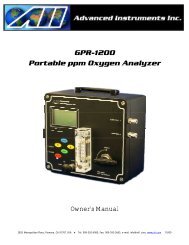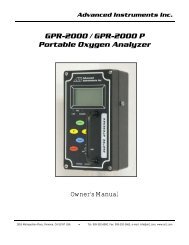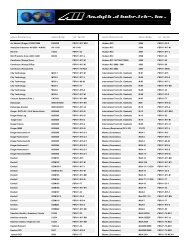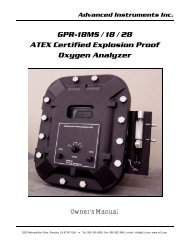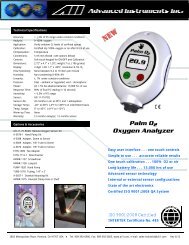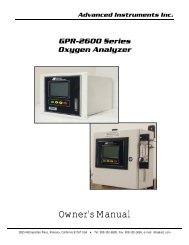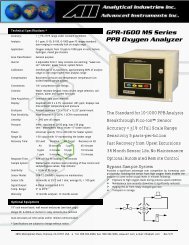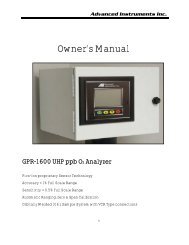GPR-1800 AIS ATEX Trace PPM Oxygen Analyzer - Advanced ...
GPR-1800 AIS ATEX Trace PPM Oxygen Analyzer - Advanced ...
GPR-1800 AIS ATEX Trace PPM Oxygen Analyzer - Advanced ...
- No tags were found...
You also want an ePaper? Increase the reach of your titles
YUMPU automatically turns print PDFs into web optimized ePapers that Google loves.
<strong>Advanced</strong> Instruments Inc.The <strong>GPR</strong>-<strong>1800</strong><strong>AIS</strong> is supplied without a sample conditioning system thereby giving users the option of adding their own orpurchasing a factory designed sample conditioning system. Whatever the choice, the sample must be properly presented to thesensor to ensure an accurate measurement. Users interested in adding their own sample conditioning system should consult thefactory. <strong>Advanced</strong> Instruments Inc. offers a full line of sample handling, conditioning and expertise to meet your applicationrequirements. Contact us at 909-392-6900 or e-mail us at info@aii1.com.Accuracy & CalibrationSingle Point Calibration: As previously describedthe galvanic oxygen sensor generates an electricalcurrent proportional to the oxygen concentration inthe sample gas. In the absence of oxygen the sensorexhibits an absolute zero, e.g. the sensor does notgenerate a current output in the absence of oxygen.Given these linearity and absolute zero properties,single point calibration is possible.Pressure: Because sensors are sensitive to thepartial pressure of oxygen in the sample gas theiroutput is a function of the number of molecules ofoxygen 'per unit volume'. Readouts in percent arepermissible only when the total pressure of thesample gas being analyzed remains constant. Thepressure of the sample gas and that of the calibrationgas(es) must be the same (reality < 1-2 psi).Temperature: The rate oxygen molecules diffuse into the sensor is controlled by a Teflon membrane otherwise known as an'oxygen diffusion limiting barrier' and all diffusion processes are temperature sensitive, the fact the sensor's electrical outputwill vary with temperature is normal. This variation is relatively constant 2.5% per ºC. A temperature compensation circuitemploying a thermistor offsets this effect with an accuracy of +5% or better and generates an output function that isindependent of temperature. There is no error if the calibration and sampling are performed at the same temperature or if themeasurement is made immediately after calibration. Lastly, small temperature variations of 10-15º produce < 1% error.Accuracy: In light of the above parameters, the overall accuracy of an analyzer is affected by two types of errors: 1) thoseproducing 'percent of reading errors', illustrated by Graph A below, such as +5% temperature compensation circuit, tolerancesof range resistors and the 'play' in the potentiometer used to make span adjustments and 2) those producing 'percent of fullscale errors', illustrated by Graph B, such as +1-2% linearity errors in readout devices, which are really minimal due to today'stechnology and the fact that other errors are 'spanned out' during calibration.Graph C illustrates these 'worse case' specifications that are typically used to develop an transmitter's overall accuracystatement of < 1% of full scale at constant temperature or < 5% over the operating temperature range. QC testing is typically< 0.5% prior to shipment.Example 1: As illustrated by Graph A any error, play in the multi-turn span pot or the temperature compensation circuit,during a span adjustment at 20.9% (air) of full scale range would be multiplied by a factor of 4.78 (100/20.9) if used formeasurements of 95-100% oxygen concentrations. Conversely, an error during a span adjustment at 100% of full scale range isreduced proportionately for measurements of lower oxygen concentrations.7



